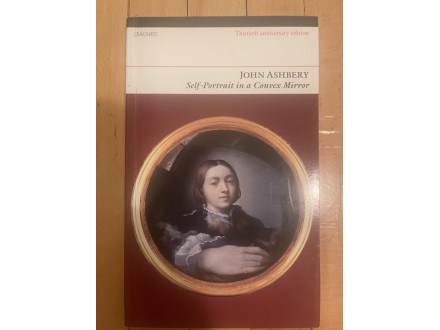John Ashbery - Self Portrait in a Convex Mirror
| Cena: |
| Želi ovaj predmet: | 5 |
| Stanje: | Polovan bez oštećenja |
| Garancija: | Ne |
| Isporuka: | Post Express |
| Plaćanje: | Tekući račun (pre slanja) |
| Grad: |
Beograd-Voždovac, Beograd-Voždovac |
ISBN: Ostalo
Godina izdanja: -
Jezik: Engleski
Autor: Strani
Jako lepo ocuvana.
Carcanet Press
Self-Portrait in a Convex Mirror is a 1975 poetry collection by the American writer John Ashbery. The title, shared with its final poem, comes from the painting of the same name by the Late Renaissance artist Parmigianino. The book won the Pulitzer Prize, the National Book Award, and the National Book Critics Circle Award, the only book to have received all three awards.
Ashbery developed an early, idiosyncratic, avant-garde poetic style that attracted little critical notice—and the few reviews he did receive were usually negative.[1] His first collection, Some Trees (1956), was chosen by W. H. Auden as the winner of that year`s Yale Series of Younger Poets Competition. Despite this, evidence suggests that Auden—whom Ashbery frequently described as his most significant literary influence—did not actually enjoy Ashbery`s writing.[note 1]
Ashbery adopted an avant-garde style for The Tennis Court Oath (1962) at the cost of brutally negative reviews. Critics derided the book as incomprehensible and absent of any redeeming qualities, which almost drove Ashbery to quit writing poetry altogether.[1]
He was grouped with the so called `New York School`, a loose collection of modern poets with ties to the contemporary art and new music scenes in New York City.[2] The group included his close friend Frank O`Hara, as well as Kenneth Koch, James Schuyler, and Barbara Guest.[3] Though Ashbery thought the label was ridiculous—he lived in Paris, not New York, from 1956 until the mid-1960s—it helped to raise his profile. His third collection, Rivers and Mountains (1966), was nominated for a National Book Award and received modest praise from critics.[1]
Asked in 1976 about the widely held opinion that his early poems were “too difficult”, if not outright impossible to understand, he replied:
At first, I was puzzled and hurt. I try to communicate—make clear, interpret—things which seem mysterious. The difficulty of my poetry isn`t for its own sake; it is meant to reflect the difficulty of living, the everchanging, minute adjustments that go on around us and which we respond to from moment to moment—the difficulty of living in passing time, which is both difficult and automatic, since we all somehow manage it.[4]
Having resigned himself to the idea that he would always be met with `this incomprehension` from the few readers he had, he said he decided to `make the best of a bad situation of someone who was destined never to have an audience`—though he realized the irony that, after Self-Portrait, he had in fact finally drawn an audience.[4]
Ashbery and Parmigianino`s painting
Edit
Parmigianino`s Self-portrait in a Convex Mirror (c. 1524)
Ashbery first saw a copy of Parmigianino`s Mannerist painting Self-portrait in a Convex Mirror (c. 1524) in 1950. At that time, Ashbery was pursuing an M.A. in English Literature at Columbia University. Having no plans for the summer and dreading that he would fail his upcoming final exams, he decided on impulse to postpone the exams, return home to Sodus, New York, and visit O`Hara in Boston.[5] On the train home from Boston, he read the July 16 New York Times and came across `The Magic and Mystery of Artist Parmigianino`, a review of a new book on Parmigianino by the art historian Sydney Freedberg.[6] The article included a reproduction of Self-portrait in a Convex Mirror, which had had such a profound impression on him that he wrote to friends about the `truly divine Parmigianino.`[7]
In 1959, Ashbery viewed the original painting at the Kunsthistorisches Museum in Vienna. He was struck by `the strangeness and perfection of the whole enterprise, and the dreamlike image of the beautiful young man`, and especially its title lingered in his memory.[8] During a 1973 trip to Provincetown, Massachusetts, he purchased an inexpensive portfolio of Parmigianino`s artwork from the window of a bookstore. The painting stirred him into contemplation once again, and he `slowly began to write a poem about it.`[9]
Slanje posle uplate na tekući račun.
Izbegavam da saljem kao preporucenu tiskovinu - (1) zato sto knjiga mora sa se umota u papir (i da se pohaba), ne moze u karton i (2) moze da putuje dugo.
CC posiljka - cena 200 din ali postar ne donosi kuci nego se mora u postu. CC koji se donosi na adresu je - 340 din a Postexpress je 350. Kada kupite samo mi napisite koje slanje vam odgovara.
Živim na Trošarini (Voždovac); ako bi vam odgovaralo lično preuzimanje, najbolje da svratite u moj kraj.
Predmet: 72942945











